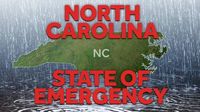North Carolina is bracing for the full force of Hurricane Erin, a powerful storm that has prompted urgent warnings, widespread closures, and a statewide state of emergency. As the hurricane barrels toward the East Coast on August 20, 2025, residents and officials alike are preparing for what could be a dangerous and destructive event, with the Outer Banks and much of the state’s coastline at the center of concern.
Governor Josh Stein did not mince words in his Wednesday address, declaring Hurricane Erin "dangerous" and issuing a clear, sobering warning to all North Carolinians. According to ABC News, Stein announced, "Dangerous Hurricane Erin is forecast to bring coastal flooding, massive waves, tropical storm-force winds, storm surge, and life-threatening rip currents to North Carolina." His message was unequivocal: safety must come first. Stein stressed, "Do not drive through floodwaters," and added, "No one should be in the ocean."
The governor’s decision to issue a statewide state of emergency underscores the seriousness of the threat. The order, effective as of August 20, 2025, is designed to mobilize resources, streamline emergency response, and signal to residents that this is no ordinary weather event. As reported by NBC News, the state of emergency comes as Hurricane Erin bears down on the East Coast, already forcing beach closures and sparking anxiety among coastal communities.
In the Outer Banks—a beloved destination for tourists and home to thousands—the mood has shifted from summer relaxation to high alert. Local authorities closed beaches up and down the coast, citing unsafe conditions from surging waves and rapidly deteriorating weather. As NBC News put it, "Hurricane Erin is bearing down on the East Coast, forcing beach closures in the Outer Banks and North Carolina." The move is intended to keep people out of harm’s way as the storm’s outer bands begin to lash the shoreline with wind and rain.
But it’s not just the beaches that are at risk. The entire coastline faces the threat of coastal flooding, with massive waves expected to batter seawalls, piers, and low-lying neighborhoods. Tropical storm-force winds—powerful enough to topple trees and damage structures—are in the forecast, and local officials are urging residents to secure loose objects, prepare emergency kits, and stay off the roads unless absolutely necessary. The National Weather Service and state agencies have been working around the clock to provide updates, but the message remains consistent: heed all warnings, and don’t take chances.
Storm surge is another major concern. When a hurricane pushes seawater onto land, the resulting rise in water levels can inundate streets, homes, and businesses in a matter of minutes. For many in North Carolina, the memory of past hurricanes—Florence, Matthew, and others—still lingers, making the prospect of another major surge all the more alarming. Governor Stein’s warning about not driving through floodwaters is rooted in hard experience; even a few inches of fast-moving water can sweep vehicles off the road, putting lives at risk.
Life-threatening rip currents have already been reported, with lifeguards and first responders stretched thin as they try to keep beachgoers safe. The governor’s plea for people to stay out of the ocean is more than just caution—it’s a matter of life and death. Rip currents can pull swimmers far from shore in seconds, and with rescue operations hampered by the storm, the risks have never been higher.
As the storm approaches, local officials have been coordinating with state and federal agencies to ensure that shelters are ready, evacuation routes are clear, and emergency crews are on standby. Many communities have activated their own emergency plans, setting up sandbag stations, distributing information door-to-door, and checking in on vulnerable residents. The sense of urgency is palpable, but so too is the determination to weather the storm.
For businesses along the coast, the timing couldn’t be worse. August is typically a peak season for tourism, and the sudden closures have upended plans for both visitors and locals. Restaurants, hotels, and shops have shuttered their doors, boarding up windows and moving inventory to higher ground. For some, the hope is that the storm will pass quickly and with minimal damage; for others, the reality of lost income and potential repairs is already setting in.
Schools in several counties have announced closures or early dismissals, and many events—ranging from outdoor concerts to local festivals—have been postponed or canceled outright. Parents are scrambling to make arrangements for their children, while emergency officials urge everyone to stay tuned to local news and official channels for the latest updates.
Throughout it all, the resilience of North Carolinians is on full display. Volunteers have stepped up to help neighbors secure homes, distribute supplies, and provide comfort to those who are anxious or alone. Social media is awash with messages of support, tips for storm preparation, and reminders to check on the elderly or those with special needs. It’s a reminder that even in the face of nature’s fury, community spirit runs strong.
Yet, the dangers posed by Hurricane Erin are not to be underestimated. As ABC News and NBC News both report, the combination of coastal flooding, massive waves, storm surge, and powerful winds make this a storm to take seriously. Officials have repeatedly emphasized that conditions can change rapidly, and that complacency could prove costly.
For those living inland, the threat of flooding remains real. Heavy rainfall associated with hurricanes can cause rivers to swell and low-lying areas to flood, sometimes days after the storm makes landfall. Emergency planners are watching river gauges and preparing for the possibility of extended power outages, road closures, and disruptions to essential services.
In the days ahead, all eyes will be on Hurricane Erin’s path and intensity. Meteorologists are tracking the storm’s every move, and while forecasts are improving, uncertainty always lingers. The hope is that with preparation, vigilance, and a bit of luck, North Carolina can avoid the worst-case scenario. But as Governor Stein’s words make clear, now is not the time for risk-taking or bravado.
As Hurricane Erin barrels toward the North Carolina coast, the state stands united—weathering the storm together, one day at a time, with resolve and caution guiding every step.






